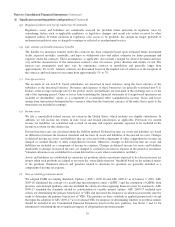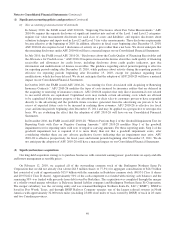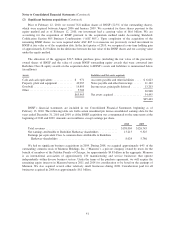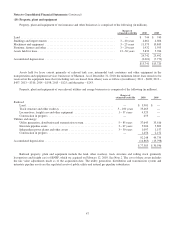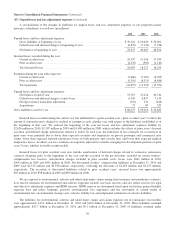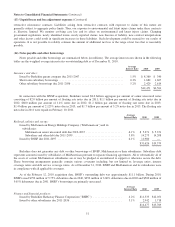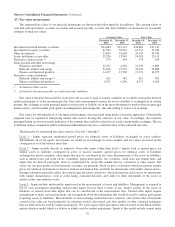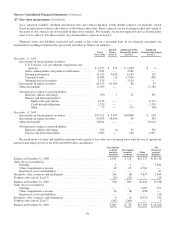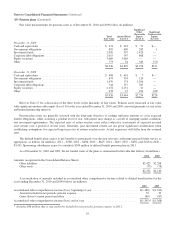Berkshire Hathaway 2010 Annual Report Download - page 51
Download and view the complete annual report
Please find page 51 of the 2010 Berkshire Hathaway annual report below. You can navigate through the pages in the report by either clicking on the pages listed below, or by using the keyword search tool below to find specific information within the annual report.
Notes to Consolidated Financial Statements (Continued)
(11) Derivative contracts (Continued)
The high yield index contracts are comprised of specified North American corporate issuers (usually 100 in number at
inception) whose obligations are rated below investment grade. High yield contracts remaining in-force at December 31, 2010
expire from 2011 through 2013. State and municipality contracts are comprised of over 500 state and municipality issuers and
had a weighted average contract life at December 31, 2010 of approximately 10.1 years. Potential obligations related to
approximately 50% of the notional value of the state and municipality contracts cannot be settled before the maturity dates of
the underlying obligations, which range from 2019 to 2054.
Premiums on the high yield index and state/municipality contracts are received in full at the inception dates of the contracts
and, as a result, we have no counterparty credit risk. Our payment obligations under certain of these contracts are on a first loss
basis. Losses under other contracts are subject to aggregate deductibles that must be satisfied before we have any payment
obligations.
Individual corporate credit default contracts primarily relate to issuers of investment grade obligations. In most instances,
premiums are due from counterparties on a quarterly basis over the terms of the contracts. As of December 31, 2010, all of the
contracts in-force expire in 2013.
With limited exceptions, our equity index put option and credit default contracts contain no collateral posting requirements
with respect to changes in either the fair value or intrinsic value of the contracts and/or a downgrade of Berkshire’s credit
ratings. As of December 31, 2010, our collateral posting requirement under contracts with collateral provisions was $31 million
compared to $35 million at December 31, 2009. As of December 31, 2010, had Berkshire’s credit ratings (currently AA+ from
Standard & Poor’s and Aa2 from Moody’s) been downgraded below either A- by Standard & Poor’s or A3 by Moody’s an
additional $1.1 billion would have been required to be posted as collateral.
Our railroad and regulated utility subsidiaries are exposed to variations in the market prices in the purchases and sales of
natural gas and electricity and in commodity fuel costs. Derivative instruments, including forward purchases and sales, futures,
swaps and options, are used to manage these price risks. Unrealized gains and losses under the contracts of our regulated
utilities that are probable of recovery through rates are recorded as a regulatory net asset or liability. Unrealized gains or losses
on contracts accounted for as cash flow or fair value hedges are recorded in accumulated other comprehensive income or in net
earnings, as appropriate. Derivative contract assets included in other assets of railroad, utilities and energy businesses were
$231 million and $188 million as of December 31, 2010 and 2009, respectively. Derivative contract liabilities included in
accounts payable, accruals and other liabilities of railroad, utilities and energy businesses were $621 million as of December 31,
2010 and $581 million as of December 31, 2009.
(12) Supplemental cash flow information
A summary of supplemental cash flow information for each of the three years ending December 31, 2010 is presented in
the following table (in millions).
2010 2009 2008
Cash paid during the year for:
Income taxes ................................................................. $ 3,547 $2,032 $3,530
Interest of insurance and other businesses .......................................... 185 145 197
Interest of railroad, utilities and energy businesses ................................... 1,667 1,142 1,172
Interest of finance and financial products businesses ................................. 708 615 522
Non-cash investing and financing activities:
Liabilities assumed in connection with acquisition of BNSF ........................... 30,968 — —
Common stock issued in connection with acquisition of BNSF ......................... 10,577 — —
Liabilities assumed in connection with acquisitions of other businesses .................. 438 278 4,763
Equity/fixed maturity securities exchanged for other securities/investments ............... — — 2,329
(13) Unpaid losses and loss adjustment expenses
The liabilities for unpaid losses and loss adjustment expenses are based upon estimates of the ultimate claim costs
associated with property and casualty claim occurrences as of the balance sheet dates including estimates for incurred but not
reported (“IBNR”) claims. Considerable judgment is required to evaluate claims and establish estimated claim liabilities.
49


